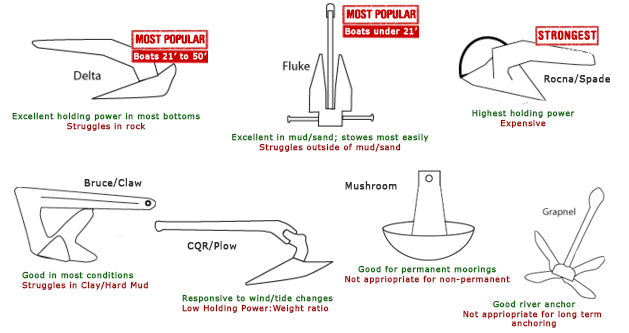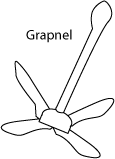Information Provided by Anchoring.com.
There are a number of boat anchors available, constructed of different materials, and often with confusing names. This article will discuss the most popular types of boat anchors, how to choose the best anchor for your boat, the most common material types, and also give an overview of different naming conventions.
Quick Anchor Style Summary

Video: Choosing an Anchor Type
Our video below introduces many of the anchor types discussed here, although the article discusses a few more anchor types and provides some useful links.
Quick Summary Boat Anchor Recommendation
For most boaters, a Bruce or Delta is the best balance between price and performance. Both perform similarly and are similarly priced (Narrowly, the Bruce/Claw is our favorite of the three).
If you’ve used a Danforth in the past, and you have had luck with it, choose a Danforth. If you’ve never used one before and if your setup allows it, choose a Bruce or Delta instead.
If you’re a blue-water cruiser, choose a CQR, or consider one of the new generation of anchors discussed below.
Boat Anchor Names: Trademarked Names and Generic Names
| Trademarked Name | Generic Name | |
| Bruce |
= |
Claw |
| CQR |
= |
Plow/Hinged Plow |
| Danforth |
= |
Fluke |
| Delta |
= |
Wing |
A special note is needed on the naming of anchors. Many anchors have a trademarked name, such as a Bruce or CQR, and a generic name like Claw or Plow. This is the same as how Xerox is a trademarked name for photocopier and how Aspirin is a trademarked name for pain killer. Trademarks effectively never expire whereas design patents expire after approximately 20-25 years. Therefore, manufacturers are free to clone an anchor design that has an expired patent but cannot use the trademarked name.
Bruce™ Claw Anchor

The Bruce, or Claw, remains one of the most popular anchors among recreational boaters in North America. This is our anchor of choice as well.
The Bruce was developed in the 70s by the Bruce Anchor Group. Once their patent expired in the early 2000s, they stopped production of this anchor but many imitations have come along since.
The Bruce is an excellent all-purpose anchor as it performs well in most sea bottoms including mud, sand, rock, and coral. It has a harder time penetrating harder surfaces, such as clay, and bottoms with heavy grass. The three-claw design sets more easily than other anchors. It also resets easily if it is ever broken loose. On the downside, the Bruce has a lower holding power per pound than other anchors, meaning you’ll usually need a larger anchor than say the Delta/Wing.
Pros: Performs well in most conditions. Sets easily.
Cons: Awkward one piece design. Lower holding power per pound.
Bottoms: Performs well in most bottoms; Struggles in hard bottoms such as clay, or heavy grass.
CQR™/Plow & Delta™/Wing Anchor


Both the CQR/Plow and the Delta/Wing are a plow style anchor. The most significant difference between these anchors is the fact that the CQR has a hinged design whereas the Delta is a one piece design.
The CQR is one of the oldest styles, dating back to the 30s and to this day, it remains one of the most popular anchors among blue water cruisers. Despite this, it has relatively low holding power and it consistently struggles in independent tests. It’s also rare to find a CQR under 25 lbs lending itself to the saying “There’s no such thing as a small CQR”. Despite these shortcomings, the hinged design makes it more responsive to wind and tide changes as compared to other anchors.
The Delta is arguably the most popular anchor on boats today, and is the standard anchor of choice used by most boat manufacturers. It has a good holding power per pound (about 50% more than the Bruce).
Both the Delta and the CQR perform well in most bottoms, struggling the most in rock.
Pros: Performs well in most conditions. Fits most bow rollers.
Cons: Hinged design can make stowage awkward. “No such thing as a small CQR/Plow anchor”.
Bottoms: Performs well in most bottoms; struggles in rock.
Danforth™/Fluke Anchor

The Danforth, or Fluke anchor, remains a very popular anchor choice. The Fortress is also a popular Fluke style anchor, different from the Danforth in that it comes apart and it constructed of light-weight, high-strength, aluminum.
The Fluke performs well in mud and sand, potentially the best of any anchor style. The downside is that outside of these bottoms, it is not a good performer. Therefore, it is a mud/sand only anchor, which fortunately is what most bottoms are comprised of.
Whether or not it is used as a primary anchor, a Fluke anchor makes an excellent choice as a secondary or stern anchor.
Pros: Performs well in mud and sand. Stows easily on most bow rollers.
Cons: Does not perform well outside of mud/sand.
Bottoms: Top performer in mud/sand. Performs poorly in other bottoms.
Plow Anchor with Roll Bar

There are several anchors on the market today that are essentially plow anchors with roll bars. These include the Rocna, Manson Supreme, and Bugel.
Each of these anchors are essentially a variation on a plow style anchor. If you look at the plow portion of these anchors, you can see they are a lot sharper than traditional plows like the Delta/Wing and CQR. Analogous to a knife through butter, these anchors can penetrate the sea bottom a lot easier than the other anchor styles. The roll bar also helps them orient themselves upright when setting.
These anchors have performed extremely well in third party tests. The biggest downside to these anchors is that because they are still patented, they can be very expensive. The roll bar along with the elongated plow can also make storing these anchors on bow rollers difficult.
Pros: Very high holding power for many models.
Cons: Difficult to stow on a bow roller. Expense.
Bottoms: Performs well in most bottoms.
Grapnel and Other Small Craft Anchors

A Grapnel anchor is generally used for small boats such as Kayaks, Dinghies, Canoes, etc. It’s also popular with fishermen.They fold up very compactly and are easy to stow. A Grapnel’s holding power comes from hooking onto another object, such as a rock. When it does hook, it can create immense holding power, which can also make retrieving the anchor difficult.
Pros: Great for use as a lunch hook. Folds to allow for compact storage.
Cons: Not appropriate for non-temporary anchorage.
Bottoms: Rock or other situations when it can hook onto an object.
Mushroom Anchors

Large Mushroom anchors are often used for permanent mooring buoys. As the silt from the sea-bottom builds up over these anchors, it can result in extreme holding power, up to 10 times the holding power of its actual weight. As a mooring buoy, the mushroom anchor is an excellent choice, however, it is not as useful in some temporary anchoring situations. An exception is that smaller versions of these anchors are good for use in small boats for anchoring while fishing or for a lunch stop over silty bottoms where the mushroom can penetrate.
Pros: If large, great for permanent mooring buoys. If small, good for use while fishing or for a lunch stop.
Cons: If large, not appropriate for non-permanent moorings. If small, only good in soft bottoms.
Bottoms: Silt, soft mud, unpacked sand.
Boat Anchor Material Types
Boat anchors come in a variety of types, the most popular being mild steel, high-tensile steel, stainless steel, and aluminum.
Most of the traditional steel anchors we are accustomed to seeing are likely either mild or high tensile steel. Mild steel and high-tensile steel are nearly indistinguishable from one another appearance wise. However, high tensile steel is 2-3 times stronger than mild steel. This isn’t to say that a high-tensile steel boat anchor has 2-3 times the holding power of its mild steel counterpart, but it will nonetheless be stronger.
Both mild steel and high-tensile steel anchors are not corrosion resistant, and therefore need to be galvanized to prevent rust and other corrosion. All steel anchors (except stainless) should be galvanized. Galvanization has a tendency to wear down over time, but an anchor (as well as nearly any other steel product) can be re-galvanized.
| Galvanized Steel
|
Stainless Steel |
Aluminum
|
|
PROs
CONs
|
PROs
CONs
|
PROs
CONs
|
Stainless steel is identical to galvanized steel in terms of holding power but differs significantly in appearance. The shiny gloss is essentially the only difference between stainless steel and galvanized steel. Stainless steel is also very corrosion resistant and will resist most rusting over time. You will often see manufacturers describing stainless steel as either 316 Stainless or 304 Stainless. 316 is a different chemical composition than 304 and is more corrosion resistant. It also more expensive.
There are some anchors constructed from high strength aluminum, such as the Fortress. These anchors are extremely lightweight while still offering high holding power. These anchors rely on bottom penetration for most of the holding power, and therefore, if they are not set, they provide little to no holding power.
READ MORE at anchoring.com



